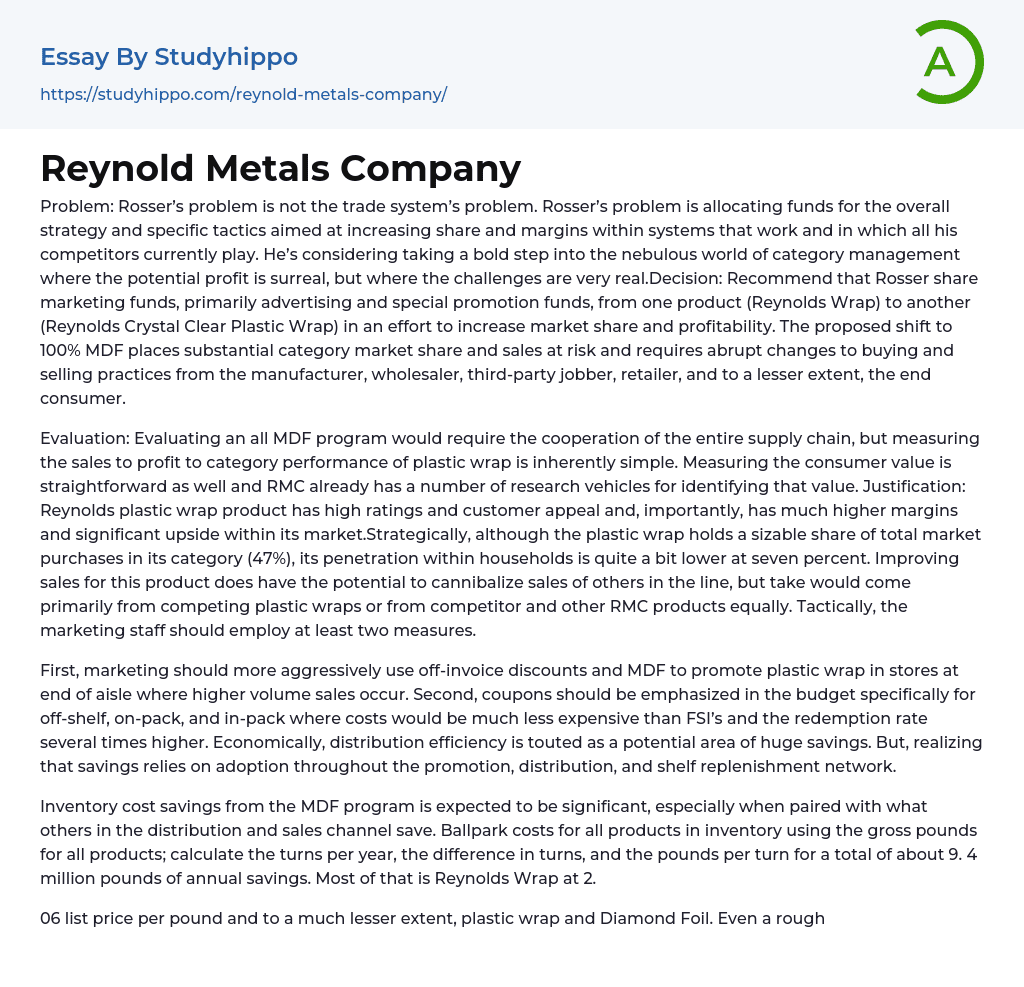Problem: Rosser’s problem is not the trade system’s problem. Rosser’s problem is allocating funds for the overall strategy and specific tactics aimed at increasing share and margins within systems that work and in which all his competitors currently play. He’s considering taking a bold step into the nebulous world of category management where the potential profit is surreal, but where the challenges are very real.
Decision: Recommend that Rosser share marketing funds, primarily advertising and special promotion funds, from one product (Reynolds Wrap) to another (Reynolds Crystal Clear Plastic Wrap) in an effort to increase market share and profitability. The proposed shift to 100% MDF places substantial category market share and sales at risk and requires abrupt changes to buying and selling practices from the manufacturer, wholesaler, third-party jobber, retailer, and to a lesser extent, the end consum
...er.
Evaluation: Evaluating an all MDF program would require the cooperation of the entire supply chain, but measuring the sales to profit to category performance of plastic wrap is inherently simple. Measuring the consumer value is straightforward as well and RMC already has a number of research vehicles for identifying that value.
Justification: Reynolds plastic wrap product has high ratings and customer appeal and, importantly, has much higher margins and significant upside within its market. Strategically, although the plastic wrap holds a sizable share of total market purchases in its category (47%), its penetration within households is quite a bit lower at seven percent. Improving sales for this product does have the potential to cannibalize sales of others in the line, but take would come primarily from competing plastic wraps or from competitor and other RMC products equally. Tactically, the marketing
staff should employ at least two measures.
- First, marketing should more aggressively use off-invoice discounts and MDF to promote plastic wrap in stores at end of aisle where higher volume sales occur.
- Second, coupons should be emphasized in the budget specifically for off-shelf, on-pack, and in-pack where costs would be much less expensive than FSI’s and the redemption rate several times higher.
Economically, distribution efficiency is touted as a potential area of huge savings. But, realizing that savings relies on adoption throughout the promotion, distribution, and shelf replenishment network.
Inventory cost savings from the MDF program is expected to be significant, especially when paired with what others in the distribution and sales channel save. Ballpark costs for all products in inventory using the gross pounds for all products; calculate the turns per year, the difference in turns, and the pounds per turn for a total of about 9. 4 million pounds of annual savings. Most of that is Reynolds Wrap at 2. 06 list price per pound and to a much lesser extent, plastic wrap and Diamond Foil. Even a rough guess would put the number at $11-14 million annually.
All MDF looks pretty good if that’s all we consider. But even though plastic wrap is currently a drag on profits, it offers a much higher gross profit per pound as noted in the table below. Bottom line here is that the payout on this system-wide execution gamble is no more than the predicted 5% loss from dropping the off-invoice discounts currently in place as noted below.
Foil PlasticD-Foil Gross
- Pounds 2693791365324351
- Less 5% 2289721160520698
- Difference #s 4040720483653
- Profit per pound 0. 91. 37 0. 37
Potential Lost
Gr.
- Profit 1171828061351
Current Operating
- Profit 38562-11039013
- Operating Profit at 5%
- Loss 26844-39097662
Albrecht’s position that discounts to retailers do “absolutely no good at all” fails to recognize that RMC’s products are not complex to produce and require no secret recipe; that the discounts drive the majority of sales for a product line that commands top dollar among peers and 44% of the combined total dollar market for plastic bags, wrap, foil, and wax paper. Reynolds Metals Company, HBS Case, 1998
- Bankruptcy essays
- Earnings essays
- Tata Group essays
- S corporation essays
- Secretary essays
- Premise essays
- Advertising essays
- Audience Theory essays
- Competitor Analysis essays
- Consumer essays
- Marketing Management essays
- Marketing Mix essays
- Marketing Plan essays
- Marketing Research essays
- Marketing Strategy essays
- Point Of Sale essays
- Price essays
- Procurement essays
- Product essays
- Product Differentiation essays
- Promotion essays
- Promotion And Marketing Communications essays
- Retailing essays
- Trademark essays
- Anheuser-busch essays
- Brands essays
- Detergent essays
- Product Placement essays
- Research Design essays
- New Product Development essays
- Advertisement essays
- Brand essays
- Sales Promotion essays
- Advertising campaign essays
- Consumer behaviour essays
- Offer And Acceptance essays
- Wal-Mart essays
- Discover essays
- Adidas essays
- Amazon essays
- Apple essays
- Bmw essays
- British Airways essays
- Burger King essays
- Coca-Cola essays
- Company essays
- Costco essays
- Dell essays
- Ebay essays
- Enron essays




